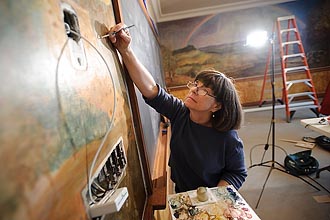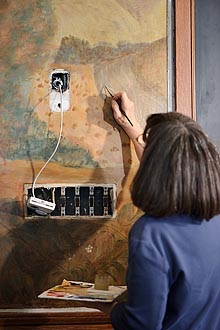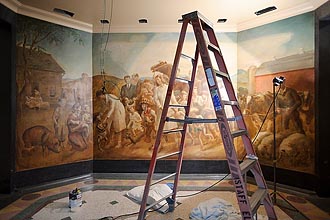Treasured campus murals conserved for future generations
At the top of a flight of construction-dusty stairs, visitors are enveloped in an octagonal foyer by floor-to-ceiling, 1940s-vintage murals depicting the societal values of advances in science.

Joan Gorman, senior paintings conservator with the Midwest Art Conservation Center, uses a small brush to repair and restore a section of a 1940s-era mural by John Steuart Curry in the Seminar room of the Biochemistry Building.
Photos: Jeff Miller
And in an out-of-the-way room just off the stairwell foyer, more John Steuart Curry murals line all four walls, leaving visitors with the feeling that they’ve walked smack-dab into an oil painting.
It’s an artistic jewel box, one that was carefully preserved by the university as the rest of the 1937 Biochemistry Building located at Henry Mall and University Avenue was gutted and rebuilt around it.
The murals were given new life as conservators from the Midwest Art Conservation Center, a nonprofit, regional conservation organization in Minneapolis, meticulously stabilized, cleaned and restored them, square inch by square inch.
“The Seminar Room murals are very thinly painted. Curry knew what he was doing. He was a great painter,” says Joan Gorman, senior paintings conservator at the center. “You can see the canvas through the paint layer, a facile and direct painting technique.”
Curry was one member of an influential triad of American regionalists that included Grant Wood and Thomas Hart Benton.
Born in Dunavant, Kansas in 1897, Curry worked as an illustrator for Boys’ Life and the Saturday Evening Post. His famous Kansas State Capitol mural “The Tragic Prelude” shows John Brown with his arms outstretched holding a rifle and a Bible.
Eventually, Curry made his way to UW–Madison as an artist in residence and the murals in the Biochemistry Building were painted from 1941–43. Curry died in 1946 but left a rich legacy.
In the stairwell foyer, the murals painted on a heavier canvas material depict, in darker, drearier tones, life without science. The people are grim and emaciated, the crops spindly, and the animals weak and feeble. In brighter tones, he shows robust children and productive agriculture, and includes faculty members of that time. Gorman says they were likely painted off-site and applied to the walls later.

Gorman works on part of the mural in the Seminar Room, which is titled “The Farm and Biochemistry.”
Just around the corner in the Seminar Room, the tone is more poetic, one wall depicting a sweeping rainbow over a productive Wisconsin farmstead, scientists in the lab and a vignette of a family seated at the dinner table. These murals were painted on a thinner muslin canvas at the site.
Before contractors renovated the building, preparations were made to ensure that the areas containing the murals were protected, says Peter Heaslett, the Facilities, Planning and Management project manager for the construction project.
Contractors worked gently in adjacent spaces as they removed old walls and building materials. The well-being of the murals was a topic of discussion in every biweekly construction meeting during the two-year project, which is ongoing.
Heaslett says the areas were protected on all sides and a special heating and ventilation system was developed to shield and insulate the murals from the elements during the winter, when main building systems were removed and replaced. During construction, all water pipes were routed around the murals because leaks in past decades had damaged the murals. A dry sprinkler system was also installed.
In early October, Gorman and colleagues Elizabeth Buschor and David Marquis came in for about 10 days of painstaking work conserving and restoring the murals.
Gorman says the center’s philosophy is conservative, using the least amount of intervention for the maximum structural and cosmetic effect.
“We save as much of the original as possible. We’re only dealing with the areas of loss,” Gorman says, noting that some damaged and delaminated canvas in the Seminar Room and foyer was repaired and reattached.

“The Social Benefits of Biochemical Research,” a 1940s-era mural by John Steuart Curry located in the stairwell foyer of the Biochemistry Building at the University of Wisconsin–Madison, is pictured during restoration.
Buschor works carefully with a tiny watercolor brush and palette of non-discoloring synthetic medium to “in-paint” small losses, while Marquis lies on his side to repair damage near the floor in the foyer.
“We cleaned a lot of dirt off of the surface,” Gorman says. “We did that with dry cleaning techniques and a very light aqueous cleaning, being careful not to use too much of our cleaning solutions.”
Then, they applied a very thin coat of protective varnish. Because of a well-documented 1985 restoration of the murals, conservators knew exactly what type of varnish to apply and in what quantities. All of the center’s work requires detailed condition and treatment reports that can help future conservators.
“The 1985 varnish is a stable, synthetic resin which is used instead of natural resins, which yellow and age very poorly,” Gorman says. “We use that varnish today. It’s still a horse in our stable. The thin layer of varnish we added is different but entirely compatible with, and will not affect, the 1985 varnish.”
Other renovations in the Seminar Room will make a tremendous difference. Harsh fluorescent lighting fixtures will be replaced by period pendant lamps with eight “sailor-hat” globes. Cork floors will be installed, as they were in the original building. And an unflattering, four-foot wainscoting of plastic laminate will be replaced by wood.
As Gorman described Curry’s approach and style as a muralist, a freight train rumbled by, blowing its piercing whistle just outside the window as it approached the University Avenue crossing. Gorman smiled.
“Listen to that,” she says. “That’s the same kind of train whistle that Curry probably listened to when he was painting this.”



